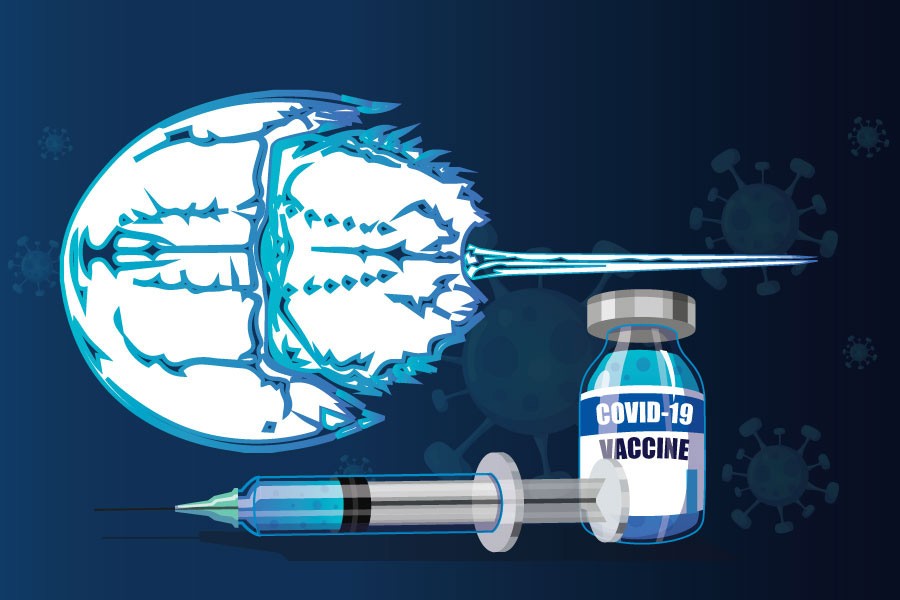While taking a beach walk along the shore of St. Martin's island, tourists often stumble upon a stingray-like creature. Many freak out at first sight while others try to catch the always moving creature for fun.
If you ask a local person, s/he will introduce the beautiful and harmless creature – a crab in the shape of a horseshoe – as Raj Kakra or Sagar Kakra. They are available along the coast of Cox's Bazar, St. Martin's, Sonadia, Moheshkhali islands and chars of the Sundarbans.
Strangers may not know these crabs have been a crucial part of developing vaccines and drugs. And in recent times, they have become more important than ever, thanks to the urgency of making a Covid-19 vaccine.
Why horseshoe crabs?
Horseshoe crabs can be considered as an aristocrat species for literally having what is idiomatically called blue blood and due to their history and significance in the biomedical industry. Predating the dinosaurs, the horseshoe crabs have been roaming the earth for more than 400 million years. They are largely found in North America along the Atlantic and Gulf coasts from Maine to Mexico and Southeast Asia. And their blue blood has now become an integral part of manufacturing a Covid-19 vaccine.
Vaccine testing
Unique copper-enriched blue blood of horseshoe crab contains an antoxin called ‘Limulus Amebocyte Lysate,’ or LAL, which coagulates or clumps up in the presence of bacterial toxins. It was discovered by American Medical Researcher Fredrick Bang in the 1950s. Whenever a vaccine or injection is made, it has to go through a LAL test. In this test, a minuscule drop of LAL is added to any vaccine or drug and it even cages the trace number of bacteria present there alarming the doctors about potential lethal infections.
The same goes for any potential Covid-19 vaccine. The blood of horseshoe crabs is hypersensitive to endotoxins, a bacterium that can enter the bloodstream through injections. Hence, it has become a perfect testing agent to check if a vaccine is harmful to the human body. Millions of doses of vaccine waiting to be produced will go through this test. Hence, production of LAL has become exclusive for pharmaceutical and biotechnological companies.
The scenario in Bangladesh
In Bangladesh, this living fossil is highly undervalued as there is no measure to preserve them or use them for the fast growing pharmaceutical industry of the country. However, locals use it for varied purposes. This crab is often caught in fishing nets by coastal fishermen to use as baits for fishing eels and conch shells. Fishermen in Sundarbans region use its tail to cure pain like rheumatism by tying a lace made of its hollow tail and string. Malformed crab embryos found in the polluted places are used as a bioindicator for analysing seawater pollution.
The tribal Maghs in Moheskhali and Sonadia islands, on the other hand, eat protein rich un-laid eggs of this crab by frying in oil. Shore birds also have feasts at full moon nights in March through May when larvae and juveniles come out of the sand nest and move towards the sea through beaches.
Unfortunately, the number of horseshoe crabs is declining fast and swarms of them can no longer be found at the confluence of the rivers and canals of different sea coasts in Bangladesh. It is sad how instead of utilising these natural resources for our own good, we are letting them go extinct.
The Fisheries Research Institute of Bangladesh has observed that a number of powerful international rackets, including some local fish farms as well, have been smuggling this valuable resource out of the country. Bangladesh hasn’t even started harvesting for the blue blood yet, but this creature has already become endangered here and that is a matter of great regret.
Maria Anis Chowdhury is currently studying mass communication and journalism at Dhaka University. She can be reached at [email protected]


